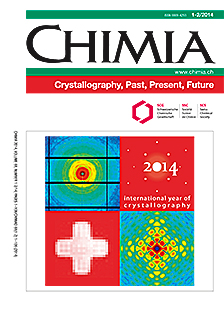'Seeing' Atoms: The Crystallographic Revolution
DOI:
https://doi.org/10.2533/chimia.2014.8Keywords:
Bragg, Laue, Service crystallography, Structure determination, X-ray diffractionAbstract
Laue's experiment in 1912 of the diffraction of X-rays by crystals led to one of the most influential discoveries in the history of science: the first determinations of crystal structures, NaCl and diamond in particular, by W. L. Bragg in 1913. For the first time, the visualisation of the structure of matter at the atomic level became possible. X-ray diffraction provided a sort of microscope with atomic resolution, atoms became observable physical objects and their relative positions in space could be seen. All branches of science concerned with matter, solid-state physics, chemistry, materials science, mineralogy and biology, could now be firmly anchored on the spatial arrangement of atoms. During the ensuing 100 years, structure determination by diffraction methods has matured into an indispensable method of chemical analysis. We trace the history of the development of 'small-structure' crystallography (excepting macromolecular structures) in Switzerland. Among the pioneers figure Peter Debye and Paul Scherrer with powder diffraction, and Paul Niggli and his Zurich School with space group symmetry and geometrical crystallography. Diffraction methods were applied early on by chemists at the Universities of Bern and Geneva. By the 1970s, X-ray crystallography was firmly established at most Swiss Universities, directed by full professors. Today, chemical analysis by structure determination is the task of service laboratories. However, the demand of diffraction methods to solve problems in all disciplines of science is still increasing and powerful radiation sources and detectors are being developed in Switzerland and worldwide.Downloads
Published
2014-02-26
Issue
Section
Scientific Articles
License
Copyright (c) 2014 Swiss Chemical Society

This work is licensed under a Creative Commons Attribution-NonCommercial 4.0 International License.
How to Cite
[1]
D. Schwarzenbach, Chimia 2014, 68, 8, DOI: 10.2533/chimia.2014.8.







